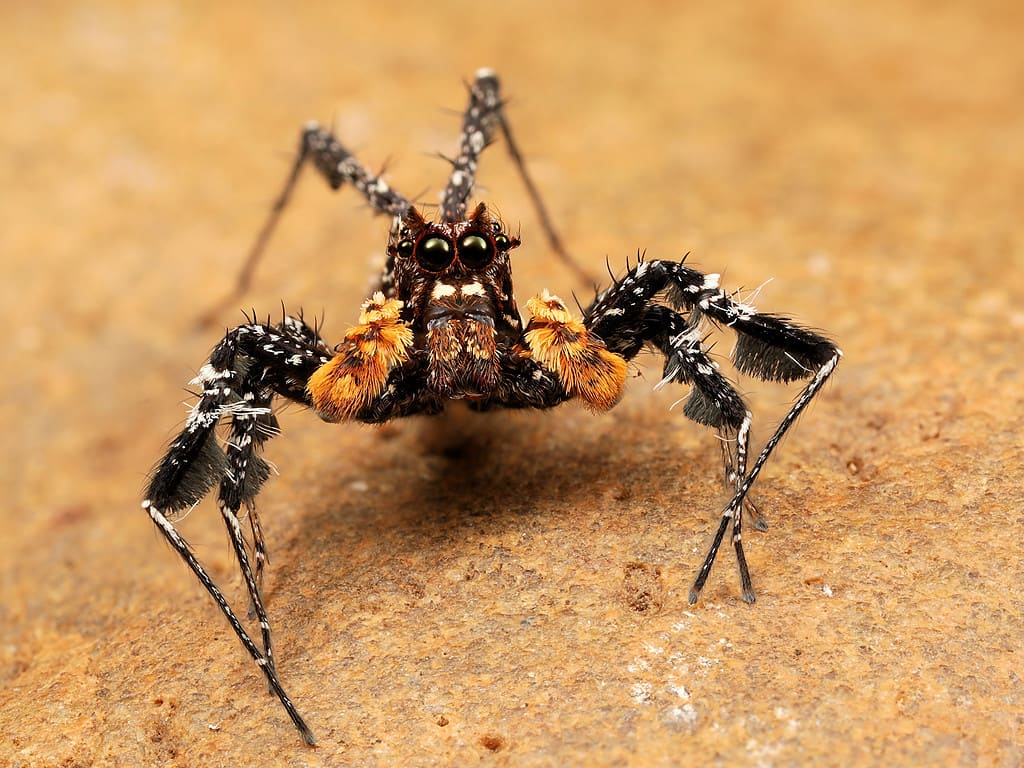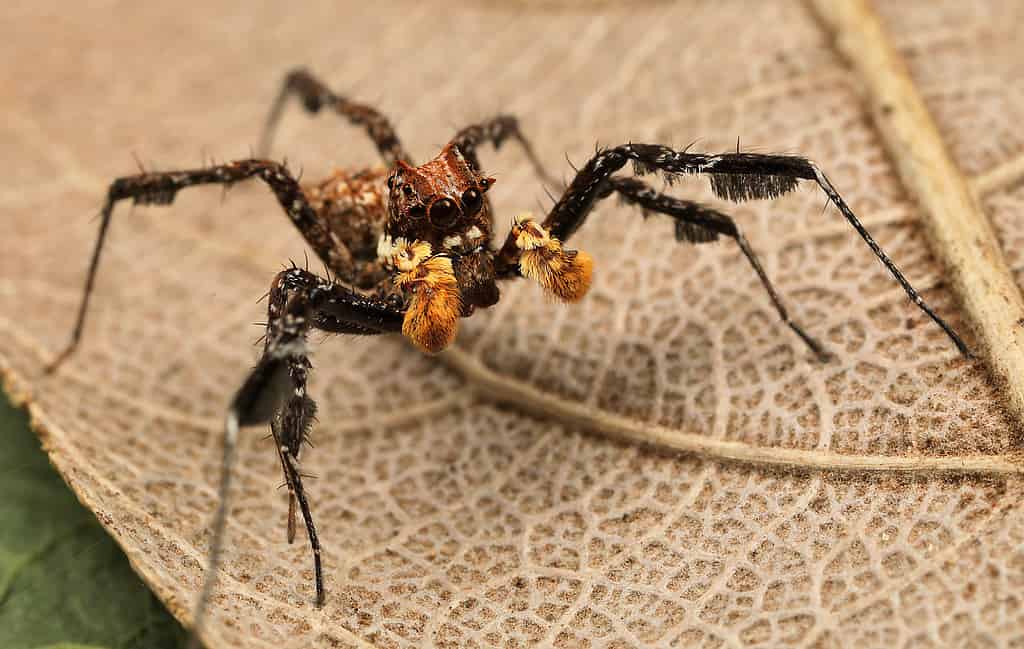Many people believe that because spiders are so small, they have tiny brains and are not very intelligent. It is popular belief that they need some sort of critical mass of brain tissue to carry out complex behaviors. However, it is very common for spiders to have cognitive abilities instead of automatic responses. From ghost spiders trained to associate positive reinforcement with the smell of vanilla to the orb weavers that build their webs based on the type of animals they want to catch, spiders are more intelligent than people give them credit for. Therefore, it doesn’t matter how big their brains are; it’s what they can do with it. So, are spiders smart? Below is everything you need to know about their intelligence.
Spiders Can be Surprised

Portia spiders have the cognitive ability to form mental images and are surprised when something doesn’t match up.
During a study of Portia spiders, researchers found that they use mental representation. The study was based on a common psychological experiment designed to evaluate the cognition of infant humans. The researchers decided that since both infants and spiders can’t tell you what they are thinking, they can determine what they understand by observing what surprises them. For example, they put down a barrier and moved a fire truck behind the left side. Then, either a fire truck or stuffed bunny appears from the right side. When the bunny appears, the infants tend to stare at it longer than they would if the fire truck appeared as expected. The researchers deduced that infants had formed a mental image of the fire truck and were shocked when the bunny didn’t look the same.
To see if spiders would react the same way, the researchers built a prey display for the Portias. They would first show the spiders one prey for 30 seconds and then close the shutter and swap the image with a different species before lifting the shutter 90 seconds later. For example, the Portias first saw an orb weaver and then a dewdrop spider. The researchers found that if these spiders saw a different prey once they lifted the shutter, they were less likely to attack than if the same prey was visible. Therefore, they deduced that Portias can form mental images and were surprised when the end result didn’t match.
Spiders Can Strategize

Portia spiders use various strategic techniques to hunt their prey.
There are several examples of spiders that can strategize. One being the jumping spider belonging to the genus Portia. These spiders occur in Africa, Australia, and Asia and are extremely smart. One example of their intelligence is their hunting techniques and preferred prey. The techniques differ depending on their prey. Portia jumping spiders prefer eating other spiders, like jumping spiders from the genus Euryattus. The Portia spider uses a sneaky trick to catch this prey.
Female Euryattus spiders build nests in dead leaves and suspend them in mid-air with silk attached to vegetation or rocks. When males court these females, they crawl down the silk rope, and once they reach the nest, they shake it in a certain way. This signals the female to come out of her nest. Portia spiders mimic the same shake, which draws the female into an ambush.
Furthermore, these smart spiders use a different technique when hunting other arachnids that also eat jumping spiders. For example, when preying on a web-building spider, they deceive them by plucking a few silk strands on their webs. This draws the web-building spider out of hiding, thinking it has caught its next meal. However, if they are hunting more dangerous spiders, they will gently disturb the web, similar to a fruit fly making contact with a single strand right at the edge. This draws the spider to the furthest point of the web, close enough for the Portia spider to pounce and strike with their venomous fangs. But, if these techniques don’t work, Portia jumping spiders have one more trick up their sleeves. They shake the entire web, mimicking a gust of wind. This allows them to climb over the web towards their prey without detection.
Black Widows Have Memories

Black widows and other species of web-building spiders use the waiting game technique, where they sit and wait until their prey gets entangled. Once they have entrapped their prey, they devour it in a gruesome fashion.
©Sari ONeal/Shutterstock.com
The name black widow invokes fear all over the world. However, these venomous spiders rarely inhabit the same areas as humans. Black widows and other species of web-building spiders use the waiting game technique, where they sit and wait until their prey gets entangled. Once they have entrapped their prey, they devour it in a gruesome fashion. Many scientists and professors believed that web-spinning spiders were more primitive than species that actively hunt. However, some professionals disagree.
Scientists evaluated the black widow’s memory to see how good it was. They did that by allowing them to get used to a web that housed captured prey. However, they would later move the spider to a different web without prey. The web-building spider would search for the prey from their previous web, plucking at the silk threads and deciphering the vibrations. Furthermore, when live prey was added to the second web, the spider continued to search for the prey from the previous web. Therefore, it proves that spiders have memories and will remember where previous meals are located.
This behavior is not only limited to black widows; it is seen in other web-building spiders as well. Furthermore, once they catch their prey, they reconstruct the area of their web where it happened to make it better equipped for catching prey. They do this by tightly pulling the threads in that area, creating a higher success rate. Because of this behavior, these spiders are not only intelligent; it also shows that they learn from and remember their experiences.
Spiders Determine Risk
It is not easy being a spider in the wild. There are a lot of threats lurking around every corner. While most spiders are known for their hunting abilities, they have many predators as well, like:
- Lizards
- Birds
- Toads
- Mud-Dauber wasps
- Ants
- Other spiders
Mud-dauber wasps are especially cruel. They paralyze spiders and entomb them inside cells in their nests so that their hatching larvae can eat them alive.
However, some spiders are skilled at escaping dangerous situations. For example, spiders belonging to the genus Portia don’t like water. So, an experiment was conducted with a spider on a platform surrounded by water. There were four options across the water, involving leaping between wooden dowels. Most Portia spiders took the shortest and safest route, requiring the fewest jumps. However, when they chose a different route, it was usually the longest one, with the most dowels. But there was a reason for this: the longest route was curved, helping the spiders to take shortcuts by skipping dowels. So, they actually cheated and outsmarted the test.
Spiders Know When They Are Outnumbered
This study was carried out on a species from Kenya, Portia africana. They placed the spiders on a viewing tower and let them observe a number of prey items at the bottom. However, while the spider was en route to the prey, they switched the number of prey items. When the Portia africana arrived at the bottom, and there were two prey spiders instead of one, it was less likely to attack. The same result happened with two vs. three prey items. Furthermore, they were also less inclined to attack if they initially saw two prey items and arrived to only one. As a result, the scientists deduced that spiders know when they are outnumbered and can also count.
The photo featured at the top of this post is © Sari ONeal/Shutterstock.com
Thank you for reading! Have some feedback for us? Contact the AZ Animals editorial team.







